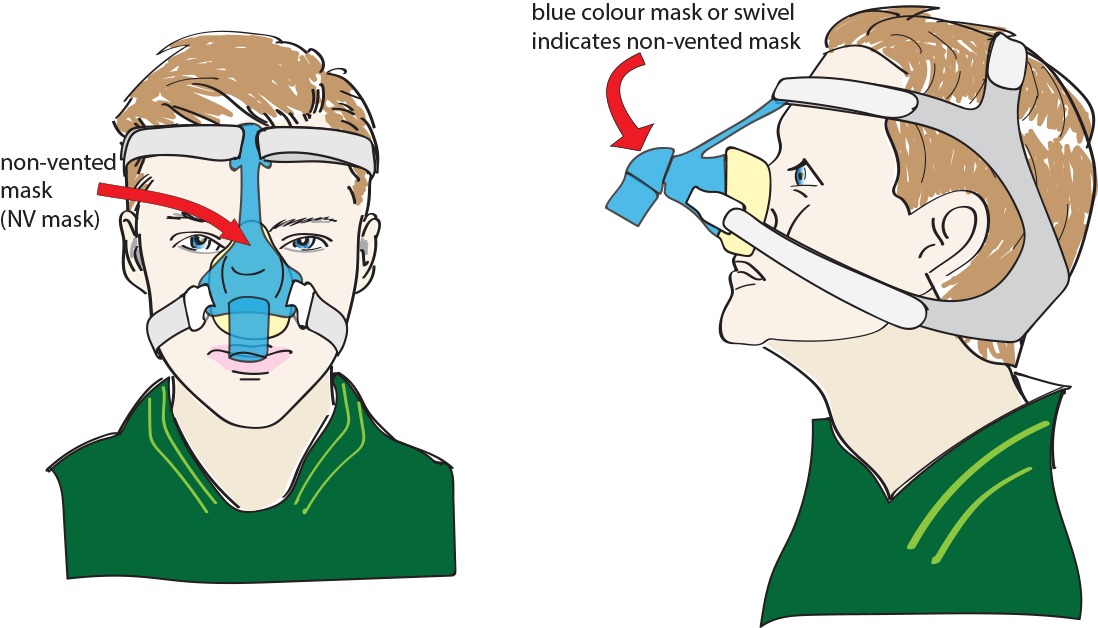Module 2: Breathing with
Choosing a mask
Different types of masks and which to choose
When choosing a mask it is essential to consider the individual diagnose, level of physical function, age and whether assistance will be needed to put on/take off the mask. Masks must be chosen in consultation with the patient after testing various alternatives. Several types of masks are available: Masks that just cover the nose, masks that cover both the mouth and nose, face-covering masks or masks that are used on/in the mouth.
Masks that cover the nose
Nasal masks
Nasal masks are often the first choice. Many different types of nasal masks are available, both with and without exhalation ports. A blue elbow usually indicates non-vented mask. Some masks have a replaceable elbow. Some examples:

Nasal prongs

Non-vented nasal mask for use with either active valve circuit or separate, disposable passive valve.
Specially molded nasal masks
Nasal masks can also be customized, specially molded. This can be done as a last option if factory-made masks cannot be used. Molded masks are tight fitting without exhalation ports. Therefore, it is necessary to use exhalation ports in the circuit between the mask and tube when using this type of mask with BiPAP therapy.

Customized mask.
Nasal prongs
Several types of prongs are available. All have exhalation ports and are therefore used with BiPAP therapy and less commonly with a "respirator" circuit. Some examples:

Neseproppmaske
About nasal masks and nasal prongs in general
- The user must be able to breathe with a closed mouth to obtain the best possible effect from therapy (avoid ‘gusts’ due to pressure being expelled through the mouth).
- The mask can also be combined with a chin strap in the event of leakage from the mouth.
- The masks are small:
- Reduced risk of pressure sores,
- Reduced feeling of claustrophobia.
- The mouth is not restricted (one can talk/eat).
- Spectacles can also be worn when using a nasal mask during mask therapy.

Masks that cover both the nose and mouth (oronasal)
Masks that cover both the nose and mouth may be appropriate in heavy mouth breathers and cases of permanent tight nose passage. These masks are also available with/without exhalation ports. A blue elbow indicates a non-vented mask. Some masks have a replaceable elbow.
All oronasal masks that have exhalation ports also have a safety valve, commonly placed in the elbow. This is an additional and wide hole in the mask, with a ‘silicon flap’ acting as a valve to open or close with air flowing into the mask. If the machine stops, the valve opens and room air can enter the mask,avoiding rebreathing, that is inhaling used air from a closed circuit.
The head straps are available in various sizes. They must not be too large. If they are, it will be difficult to tighten them properly.
 Oronasl mask
Oronasl mask
Total-face masks
Total face masks are not normally the first choice. They are mainly used temporarily to relieve pressure sores on the nose. They do not touch the nose and therefore provide good relief. Despite covering total face they do not cause ‘gusts’ in the eyes, but there might some slight fogging (especially when using humidification on the machine). As a result, it might be more difficult to look out of the mask. Therefore, they are more suitable as a ‘night mask’.

Total-face mask
Oral mask and mouthpiece
Oralventilation is an alternative for the relief of pressure sores. Problem may be increased risk of vomiting, dryness of the mouth or the secretion of saliva.
A mouthpiece can be a good alternative when daytime therapy is needed. As such, the patient will not have to wear a face mask 24 hours of the day. It is also convenient in a wheelchair and for airstacking procedure.The mouthpiece can be attached to an arm, e.g. on a wheelchair, and the patient can take a ‘sip of air’ from the mouthpiece when necessary. In order for it to work, the patient should have enough muscle power in his/her lips, so he/she can tighten his/her lips around the mouthpiece upon aspiration.

Oral mask

Jørgen with his mouthpiece

Jørgen using mouthpiece ventilation in his wheelchair. Different choices in mouthpiece size and angle, attachment to wheelchair etc.